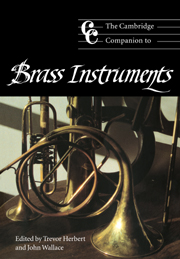Book contents
- Frontmatter
- Introduction
- 1 Lip-vibrated instruments of the ancient and non-western world
- 2 How brass instruments work
- 3 Design, technology and manufacture before 1800
- 4 Brass instruments in art music in the Middle Ages
- 5 The cornett
- 6 ‘Sackbut’: the early trombone
- 7 The trumpet before 1800
- 8 The horn in the Baroque and Classical periods
- 9 Design, technology and manufacture since 1800
- 10 Keyed brass
- 11 The low brass
- 12 Brass in the modern orchestra
- 13 Brass bands and other vernacular brass traditions
- 14 Playing, learning and teaching brass
- 15 The post-classical horn
- 16 Jazz, improvisation and brass
- 17 Brass solo and chamber music from 1800
- 18 Frontiers or byways? Brass instruments in avant-garde music
- Glossary
- Notes
- Select bibliography
- Index
4 - Brass instruments in art music in the Middle Ages
Published online by Cambridge University Press: 28 September 2011
- Frontmatter
- Introduction
- 1 Lip-vibrated instruments of the ancient and non-western world
- 2 How brass instruments work
- 3 Design, technology and manufacture before 1800
- 4 Brass instruments in art music in the Middle Ages
- 5 The cornett
- 6 ‘Sackbut’: the early trombone
- 7 The trumpet before 1800
- 8 The horn in the Baroque and Classical periods
- 9 Design, technology and manufacture since 1800
- 10 Keyed brass
- 11 The low brass
- 12 Brass in the modern orchestra
- 13 Brass bands and other vernacular brass traditions
- 14 Playing, learning and teaching brass
- 15 The post-classical horn
- 16 Jazz, improvisation and brass
- 17 Brass solo and chamber music from 1800
- 18 Frontiers or byways? Brass instruments in avant-garde music
- Glossary
- Notes
- Select bibliography
- Index
Summary
The role of brass instruments in the Middle Ages, especially in the earlier Middle Ages, remains murky. No music survives and the scant remnants of instruments allow only the most fragmentary notions of what the actual structure and shapes of trumpets and horns of the time might have been. Literary and theoretical sources seldom mention brass instruments, and few pictures illustrate them. Only towards the end of the medieval era do the sources, especially pay records and iconography, provide more ample evidence.
What is clear, however, is that, throughout the time span, brass instruments maintained their associations with ritual and function. High ceremonies demanded the blare of trumpets, and armies, too, evidently continued the Roman tradition of communication and signalling by means of horns and trumpets of various types. These ritualistic legacies evidently laid the base for new directions which became evident in the fifteenth century, as various types of brass instruments became clearly associated with art music for the first time. It is the transition to participation in art music which marks a clear differentiation between the instrumental practice of the ancient world and that of the early modern era. This transition will provide the underlying theme to what follows.
Earlier Middle Ages
From the time of the break-up of the Roman Empire to the early fourteenth century the most telling transformations among brass instruments were those concerning trumpets. Horns of diverse kinds continued in use, although the details of their developments are very obscure and the use of early horns in any case seems to have had lesser impact on later medieval traditions.
- Type
- Chapter
- Information
- The Cambridge Companion to Brass Instruments , pp. 38 - 50Publisher: Cambridge University PressPrint publication year: 1997



